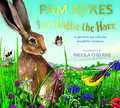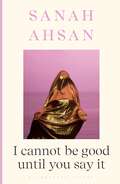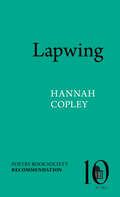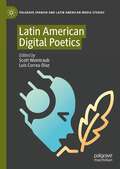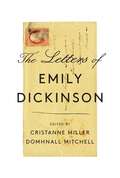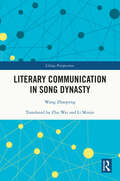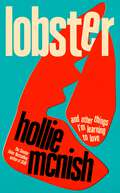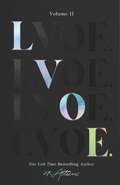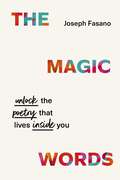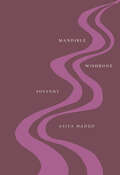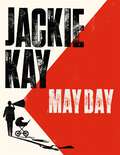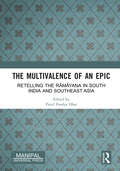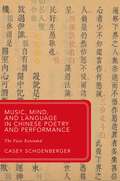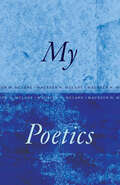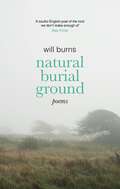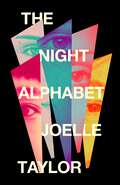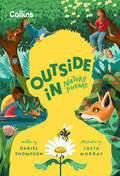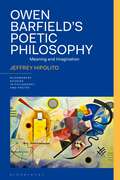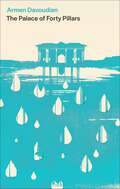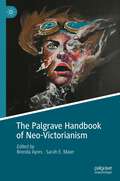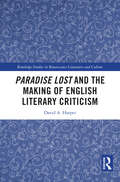- Table View
- List View
I am Hattie the Hare: A tale from our wild and wonderful meadows
by Pam AyresJoin Hattie the playful Brown Hare as she leaps from meadow to farm to heath, in this heartwarming tale written in rhyme by the much-loved poet Pam Ayres, author of The Last Hedgehog.We didn’t always live here, once we had a sunny home,We came here with centurions, all the way from Rome . . .From grape green meadows to old-fashioned farms, hares travelled thousands of miles to find a home in the British countryside. What do they eat? What's their perfect habitat? Can you tell them apart from rabbits?Wonderfully illustrated by award-winning artist Nicola O'Byrne, I Am Hattie the Hare is a follow-up to the bestselling I Am Oliver the Otter. Bursting with natural and historical facts interwoven throughout the story, and with an information spread at the end that includes tips on where to spot these gentle animals.
I cannot be good until you say it
by Sanah AhsanThe much-anticipated debut collection by the winner of the Outspoken Performance Poetry Prize: a tender meditation on queerness and Islam'Dissolving whatever boundaries would wall us off from love, Ahsan finds a way to let it all be holy' Victoria Adukwei-Bulley'When I speak of the word "sacred", Sanah Ahsan's I cannot be good until you say it will forever instantly spring to mind ... A masterpiece - an honour to have read this book, I am forever changed after reading its beauty' Nikita Gill'Innovative and deeply compassionate ... multilingual verse suffused with a vital musicality and a palpable tenderness, Ahsan calls poetry into prayer and evokes a faith safe enough to be mothered by' Mary Jean Chan'Dexterous, varied, erotic, filled with rage, worships and wonder ... I am electrified' Pádraig Ó Tuama'Tensions of psychological drama, together with an induced sense of yearning.. what an artful and inspired set of poems' Anthony Anaxagorou'Liberation is at the nucleus of every page of Sanah Ahsan's rousing debut ... Ahsan is doing liberation work, offering readers a prayer, a song, a hand to hold amidst the amidst' Kaveh Akbar'A remarkable and transformative collection' Keith Jarrett'A daring debut collection, which guides us through the complexities of just being' Yomi Sode'Alive with a want and restlessness that remakes the "You" of desire - and faith - again and again' Will Harris'A heart punching debut collection' Raymond Antrobus______________________________________________Intricately weaving Quranic verse, psychology, and the hip-hop soundtrack of their childhood, Sanah's poems reach for divinity in the body; an archive that refuses erasure.These poems traverse unruly emotional and physical landscapes, Whiteness, islamophobia, homophobia, intergenerational suffering, and the politics of therapeutic processes. In these pages, belief and unbelief, goodness and badness, the material and spiritual are intertwined, reclaiming queer love and desire as holy.How are we incarcerated by others' gazes? Who gets to be good in a society built upon hierarchy? How might we embrace each other's madnesses? Sanah Ahsan asks questions that travel to the heart of our humanness, bending the lines between psychologist and client to show us the sacred nature of our wounds. These poems kneel to the messiness of being alive, building altars to complication and presence. Refusing binaries of gender or religious doctrine, I cannot be good until you say it finds what is to be revered in the grey spaces of morality, advancing imagination and self-compassion as sites of communion.This debut collection is a call to prayer, fearlessly complicating what is good, and what is god.
Lapwing (Pavilion Poetry)
by Hannah CopleyPoetry Book Society Recommendation Summer 2024 Migrating across voices and blurring the divide between bird and human, self and other, Hannah Copley’s Lapwing explores restlessness, love, and ecological and personal grief in a vivid and incantatory sequence of poems. A lyrical biography of a bird and a fragmented study of a flawed and mutable creature bearing its name, Copley’s second collection takes inspiration from John Gower’s brid falseste of alle and its many literary guises. At the heart of the book are the shifting figures of Lapwing and Peet, two creatures whose overlapping narratives echo the double note of the bird’s cry. In Lapwing, known by countless names, migratory, and slowly disappearing beneath addiction, Copley examines a life in a slow tumble, as we are transported into a world shaped by real and imagined predators. Running alongside Lapwing is the searching voice of Peet, a daughter left to understand her father’s vanishing while trying to make a life in a habitat no longer fit for survival. Bold, exacting, and deeply personal, Copley’s poems call out from empty nests, drained wetlands, and ploughed fields to create a soundscape of endangerment and wonder. *Lapwing *asks that we consider how, like the bird itself, we must all dissemble to survive.
Latin American Digital Poetics (Palgrave Spanish and Latin American Media Studies)
by Scott Weintraub Luis Correa-DíazLatin American Digital Poetics seeks to take the pulse of emergent poetic forms whose history is entangled with the computational and its AI dreams and achievements. This study carefully and thoroughly probes the intersection between the literary, the cultural, and the scientific-technological in order to reflect on the ways that digital technology has radically reshaped and reconfigured nearly all aspects of contemporary culture. The main idea of this book, then, is simple: by way of panoramic approaches to digital poetry as well as select case studies, we seek to account for the multi-directional exchange between poetry, technology, and culture via a (primarily) pedagogical approach.
The Letters of Emily Dickinson
by Emily DickinsonThe definitive edition of Emily Dickinson’s correspondence, expanded and revised for the first time in over sixty years.Emily Dickinson was a letter writer before she was a poet. And it was through letters that she shared prose reflections—alternately humorous, provocative, affectionate, and philosophical—with her extensive community. While her letters often contain poems, and some letters consist entirely of a single poem, they also constitute a rich genre all their own. Through her correspondence, Dickinson appears in her many facets as a reader, writer, and thinker; social commentator and comedian; friend, neighbor, sister, and daughter.The Letters of Emily Dickinson is the first collected edition of the poet’s correspondence since 1958. It presents all 1,304 of her extant letters, along with the small number available from her correspondents. Almost 300 are previously uncollected, including letters published after 1958, letters more recently discovered in manuscript, and more than 200 “letter-poems” that Dickinson sent to correspondents without accompanying prose. This edition also redates much of her correspondence, relying on records of Amherst weather patterns, historical events, and details about flora and fauna to locate the letters more precisely in time. Finally, updated annotations place Dickinson’s writing more firmly in relation to national and international events, as well as the rhythms of daily life in her hometown. What emerges is not the reclusive Dickinson of legend but a poet firmly embedded in the political and literary currents of her time.Dickinson’s letters shed light on the soaring and capacious mind of a great American poet and her vast world of relationships. This edition presents her correspondence anew, in all its complexity and brilliance.
Literary Communication in Song Dynasty (ISSN)
by Wang ZhaopengBased on first-hand historical materials, this book explores the various aspects of literary communication during the Song Dynasty in China.The book investigates the single-channel dissemination of poetry and ci works, the dissemination of literary collections, the dissemination through wall inscriptions, the oral dissemination of Song ci, the remuneration and commercialization of literature in the Song Dynasty, the paths to fame for Song writers, the non-literary factors in the dissemination of literature and the dissemination of literary works through paintings and songs. The author provides insights into the six major questions in the study of literary communication: Who disseminates, where, how, what, to whom and the effects of dissemination. The author also seeks to provide detailed answers to the following questions. What was the role of female singers in both domestic and official entertainment? What were the costs and prices of the books? Who paid the authors? What methods did writers use to gain fame and social recognition?This work will be essential reading for scholars and students of Chinese studies, communication studies and media and cultural studies.
Literary Communication in Song Dynasty (ISSN)
by Wang ZhaopengBased on first-hand historical materials, this book explores the various aspects of literary communication during the Song Dynasty in China.The book investigates the single-channel dissemination of poetry and ci works, the dissemination of literary collections, the dissemination through wall inscriptions, the oral dissemination of Song ci, the remuneration and commercialization of literature in the Song Dynasty, the paths to fame for Song writers, the non-literary factors in the dissemination of literature and the dissemination of literary works through paintings and songs. The author provides insights into the six major questions in the study of literary communication: Who disseminates, where, how, what, to whom and the effects of dissemination. The author also seeks to provide detailed answers to the following questions. What was the role of female singers in both domestic and official entertainment? What were the costs and prices of the books? Who paid the authors? What methods did writers use to gain fame and social recognition?This work will be essential reading for scholars and students of Chinese studies, communication studies and media and cultural studies.
Lobster: and other things I’m learning to love: 'energising, fearless and joyful' Sara Pascoe
by Hollie McNishA brand-new collection from the award-winning poet, the companion piece to the Sunday Times bestselling Slug'Funny, so smart and refreshingly honest' SARAH MILLICAN'Hollie McNish's words always sweep me away' GIOVANNA FLETCHERThis book is written out of both hate and love for the worldAs people, we are capable of both love and hate; amazement and disgust; fun and misery. So why do we live in a world that is constantly telling us to hate, both ourselves and others? We are told to be repulsed by our own bodies, bodies that let us laugh and sweat and eat toast; to be ashamed of pleasure; to be embarrassed by fun. In this collection, Hollie McNish brings her inimitable style to the question of what have been taught to hate, and if we might learn to love again.'Never have we needed her more' STYLIST'I've loved her work for years' JO BRAND'She writes with honesty, conviction, humour and love' KAE TEMPEST
LVOE II
by AtticusIn the highly anticipated follow-up to LVOE: Poems, Epigrams & Aphorisms, three-time New York Times bestselling author Atticus is inviting readers to take a deeper look behind the mask as he continues his powerful journey inward in search of love, peace, and acceptance.LVOE. Volume II is an expanded exploration of self-love, meditation, meaning, loss, and romance from the internet's favourite poet. Atticus implores his instantly recognizable lyrical style, gorgeous illustrations, and relatable themes to once again dazzle readers, inspiring them to look within. This collection will feature all-new poems, each paired with beautiful sketches that bring the words alive from the page.LVOE. Volume II looks forward, backward, but most importantly inward to the often confusing yet hopeful human experience.
The Magic Words
by Joseph FasanoDiscover the joy of expressing what’s inside you, with fill-in-the-blank poems that are sparking a creative movement.We all have stories inside us, whether or not we consider ourselves ‘creative’. And with these 50 simple fill-in-the-blank poems, anyone can write poetry, whatever age or ability. By adding just a few words of your own, you create something beautiful and wholly new that comes from within.Discover the magic of putting your feelings into words and be inspired by sample poems submitted by people of all ages and walks of life. Exploring themes like friendship, love, grief, gratitude, and hope, these inclusive, accessible, and deceptively simple poems express powerful emotional truths, written by you.Discover the joy of expressing what’s inside you, with fill-in-the-blank poems that are sparking a creative movement
Mandible Wishbone Solvent (Phoenix Poets)
by Asiya WadudA poetry collection that brings together word, image, and sound to reflect on fractured, fragmentary states of being. The poetry of Mandible Wishbone Solvent is situated in the space of bridges, fragmentary overlays, spectral reach, and the desire to keep reaching. Asiya Wadud’s poems engage in this act, not to stake a claim or to fasten themselves, but to hold fragments together in order to offer possibilities for connection and extension. Throughout the collection lies an acknowledgment that any hold will drift, meander, and find new paths, with each separation making space for new entanglements. Drawing on a keen interest in tactility and ekphrasis, Wadud mines the repetition and extension that comes with any fractured state of existence and considers the nature of a residual and roving we. Following this selection of lyrical, ekphrastic, fragmented poems, the book concludes with two prose pieces that dwell on the concepts of “isthmus” and “drift,” respectively, which offer further grounds for contemplation and provide a frame for the poems.
Mandible Wishbone Solvent (Phoenix Poets)
by Asiya WadudA poetry collection that brings together word, image, and sound to reflect on fractured, fragmentary states of being. The poetry of Mandible Wishbone Solvent is situated in the space of bridges, fragmentary overlays, spectral reach, and the desire to keep reaching. Asiya Wadud’s poems engage in this act, not to stake a claim or to fasten themselves, but to hold fragments together in order to offer possibilities for connection and extension. Throughout the collection lies an acknowledgment that any hold will drift, meander, and find new paths, with each separation making space for new entanglements. Drawing on a keen interest in tactility and ekphrasis, Wadud mines the repetition and extension that comes with any fractured state of existence and considers the nature of a residual and roving we. Following this selection of lyrical, ekphrastic, fragmented poems, the book concludes with two prose pieces that dwell on the concepts of “isthmus” and “drift,” respectively, which offer further grounds for contemplation and provide a frame for the poems.
May Day: the new collection from one of Britain's best-loved poets
by Jackie KayMay Day is the long-awaited new poetry collection from one of our best-loved poets and former Makar of Scotland, Jackie Kay.These poems cast an eye over several decades of political activism, from the international solidarity of the Glasgow of Kay’s childhood, accompanying her parents’ Socialist campaigns, through the feminist, LGBT+ and anti-racist movements of the 80s and 90s, up to the present day when a global pandemic intersects with the urgency of Black Lives Matter.Kay brings to life a cast of influential figures, delving beneath the surfaces of received narratives: the Jamaican model Fanny Eaton, muse of the Pre-Raphaelite Brotherhood in England; Paul Robeson, Angela Davis and the poet Audre Lorde; and a ‘what-if’ poem concerning Rabbie Burns and a road-not-taken towards the West Indian slave trade. Woven through the collection is a suite of lyric poems concerning the recent losses of Kay’s parents: poems of grief and profound change that are infused with the light of love and celebration.
The Multivalence of an Epic: Retelling the Rāmāyaṇa in South India and Southeast Asia
This volume examines The Rāmāyaṇa traditions of South India and Southeast Asia. Bringing together 19 well-known scholars in Rāmāyaṇa studies from Cambodia, Canada, France, India, Indonesia, Malaysia, Singapore, Thailand, UK, and USA, this thought-provoking and elegantly illustrated volume engages with the inherent plurality, diversity, and adaptability of the Rāmāyaṇa in changing socio-political, religious, and cultural contexts. The journey and localization of the Rāmāyaṇa is explored in its manifold expressions – from classical to folk, from temples and palaces to theatres and by-lanes in cities and villages, and from ancient to modern times. Regional Rāmāyaṇas from different parts of South India and Southeast Asia are placed in deliberate juxtaposition to enable a historically informed discussion of their connected pasts across land and seas. The three parts of this volume, organized as visual, literary, and performance cultures, discuss the sculpted, painted, inscribed, written, recited, and performed Rāmāyaṇas. A related emphasis is on the way boundaries of medium and genre have been crossed in the visual, literary, and performed representations of the Rāmāyaṇa. Print edition not for sale in South Asia (India, Sri Lanka, Nepal, Bangladesh, Pakistan and Bhutan)
The Multivalence of an Epic: Retelling the Rāmāyaṇa in South India and Southeast Asia
by Parul Pandya DharThis volume examines The Rāmāyaṇa traditions of South India and Southeast Asia. Bringing together 19 well-known scholars in Rāmāyaṇa studies from Cambodia, Canada, France, India, Indonesia, Malaysia, Singapore, Thailand, UK, and USA, this thought-provoking and elegantly illustrated volume engages with the inherent plurality, diversity, and adaptability of the Rāmāyaṇa in changing socio-political, religious, and cultural contexts. The journey and localization of the Rāmāyaṇa is explored in its manifold expressions – from classical to folk, from temples and palaces to theatres and by-lanes in cities and villages, and from ancient to modern times. Regional Rāmāyaṇas from different parts of South India and Southeast Asia are placed in deliberate juxtaposition to enable a historically informed discussion of their connected pasts across land and seas. The three parts of this volume, organized as visual, literary, and performance cultures, discuss the sculpted, painted, inscribed, written, recited, and performed Rāmāyaṇas. A related emphasis is on the way boundaries of medium and genre have been crossed in the visual, literary, and performed representations of the Rāmāyaṇa. Print edition not for sale in South Asia (India, Sri Lanka, Nepal, Bangladesh, Pakistan and Bhutan)
Music, Mind, and Language in Chinese Poetry and Performance: The Voice Extended (Global Asias)
by Casey Schoenberger"Poetry puts intent into words; singing lengthens words"--this is one of the earliest Chinese comments on artistic expression. Poetic language extends the reach of a sentiment beyond the individual, and musicality extends the reach of poetic language, not only across a room, but across geography and generations. The "extended mind thesis" (EMT) views minds as extending beyond individual nervous systems to include material and social environments. Music, Mind, and Language in Chinese Poetry and Performance: The Voice Extended offers a comprehensive overview of the interwoven histories of traditional Chinese poetry and performing arts. It employs cognitive and quantitative methods such as EMT, and a database of over six thousand traditional melodies, to describe cyclical, continuous interactions between social minds and material artifacts. From the ancient Canon of Poetry to the song-lyrics (ci) of the late medieval period and the dramatic arias of Kun and Beijing operas, Casey Schoenberger introduces the rhythms, melodies, pronunciation, and grammatical stylistics of the major Chinese verse and performance traditions. In doing so, he gleans insights from cognitive neuroscience, digital humanities, musicology, and linguistics to explain not only the trajectory of Chinese arts, but also bigger phenomena, like vernacularisation and improvisation.
My Poetics
by Maureen N. McLaneAcclaimed poet and critic Maureen N. McLane offers an experimental work of criticism ranging across Romantic and contemporary poetry. In My Poetics, Maureen N. McLane writes as a poet, critic, theorist, and scholar—but above all as an impassioned reader. Written in an innovative, conversable style, McLane’s essays illuminate her own poetics and suggest more generally all that poetics can encompass. Ranging widely from romantic-era odes and hymns to anonymous ballads to haikus and haibuns to modernist and contemporary poetries in English, My Poetics explores poems as speculative instruments and as ways of registering our very sense of being alive. McLane pursues a number of open questions: How do poems generate modes for thinking? How does rhyme help us measure out thought? What is the relation of poetry to its surroundings, and how do specific poems activate that relation? If, as Wallace Stevens wrote, “poetry is the scholar’s art,” My Poetics flies under a slightly different banner: study and criticism are also the poet’s art. Punctuated with McLane’s poems and drawing variously on Hannah Arendt, Percy Bysshe Shelley, Roland Barthes, Bruno Latour, and other writers and poets, My Poetics is a formally as well as intellectually adventurous work. Its artful arrangement of readings and divagations shows us a way to be with poems and poetics.
Natural Burial Ground
by Will Burns'Will Burns is a soulful English poet of the kind we don't make enough of' Max PorterIn his beautiful, evocative new collection, Natural Burial Ground, Will Burns explores his deep interest in place and the natural world to excavate the emotional impact of grief and loss. Natural Burial Ground is by turns melancholy and musical, haunting and deeply empathetic, a collection that wrestles with the scope and heft of elegy, while retaining the poet's world-weary humour and range of imagery.There is throughout a sense of 'home' as unsettled, or unsettling - the landscapes of the Home Counties and of the Channel Islands - the very concept of islands themselves, becoming changed, haunted, in the wake of human experience.Time seeps into the soil of Natural Burial Ground. Reckoning with profound grief, and a country rife with 'Restrictions, recriminations . . .' - the poet finds the past visible everywhere on these grounds, where places come loaded with meaning across time - the deep past of archaeology, the weight of the personal-present, the reticent, uncertain future.In poems alive with familiar wildlife and the communities they move among - seabirds on the wing, the fishermen's daily catch - Natural Burial Ground speaks to our connections to landscapes, to family, the impact of climate change, pop music, wildlife and history.
The Night Alphabet: the electrifying debut novel from the award-winning poet
by Joelle Taylor'Joelle Taylor has a Midas touch with words' Diana SouhamiA Cosmo best books to look forward to in 2024 pick 'A glorious jewel of a novel' Sophie Ward'Exhilarating, profoundly beautiful and exquisitely written' Salena Godden'A mesmerising debut from one of the most talented literary stylists writing today' The Bookseller'Hugely imaginative' Marie Claire (Best New Books, 2024)---------------------------------------------------------------------------------The tattoo was a reclamation, a flag we mounted in the centre of our own landscape.A woman walks into a tattoo parlour. But this is no ordinary woman, and this is Hackney in 2233. Jones' body is covered in tattoos but she wants to add one final inking to her gallery - a thin line of ink mixed with blood that connects her body art together, creating a unique map.As the two artists set to work, Jones tells them the story behind each tattoo. As Jones is no ordinary woman, these are no ordinary stories: each one represents a doorway to a life Jones fell into, a 'remembering'. Some of these lives were in the past, others in the future, some are sideways, but each of them connects Jones to the two tattoo artists in some way, though they are unaware of it.We visit the dystopian cities of the Quiet Men, the coal mines of 19th century Lancashire, join a gang of vigilante sex workers, enter the world of an INCEL murderer, haunt the old Maryville gay bar, and uncover plans to genetically modify female children. Each of the stories brings us closer to Jones' truth, and how her life is intricately interwoven with that of the women tattooing her body.Set across geographies and timespans, The Night Alphabet is a dazzlingly bold and original work, a deep investigation into human nature and violence against women.
One Love: Romantic Quotes for the LGBTQ+ Community
by Summersale PublishersLove is for everyone and should be celebrated. It is a universal experience that transcends boundaries, gender and sexuality. Show your special someone how important they are to you with this diverse selection of thoughtful words. Be proud of your love and love with everything you have, because love is the most powerful thing in the world.
Owen Barfield’s Poetic Philosophy: Meaning and Imagination (Bloomsbury Studies in Philosophy and Poetry)
by Dr Jeffrey HipolitoThe first book to offer an overview, at once introductory and comprehensive, of the philosophical thought of Owen Barfield, sometimes known as the “first and last Inkling” and as the “British Heidegger.”Beginning by placing Barfield's early poetics in the context of the critical hurly-burly of modernist London of the 1920s, Owen Barfield's Poetic Philosophy: Meaning and Imagination shows how Barfield's subsequent development of a philosophy of history, metaphysics, and ethics culminates in his development of a poetic cosmology. Hipolito situates Barfield's poetic philosophy in relation to his significant contemporaries (and predecessors) including T.S. Eliot, D.H. Lawrence, I.A. Richards, Jean Paul Sartre, Martin Heidegger and Ernst Cassirer, bringing to light for the first time many important aspects of Barfield's thought. The book concludes with an analysis of the Burgeon trilogy, in which Barfield recapitulates the themes and arguments of his poetic philosophy by exemplifying them in three genre-defying works of fiction.Structured chronologically and giving a systematic examination of Barfield's thought, Owen Barfield's Poetic Philosophy paints a much-needed picture of a major thinker and poet, who was entirely engaged with his times and who remains crucially relevant to our own.
The Palace of Forty Pillars
by Armen Davoudian'In this formally radical debut, Armen Davoudian shows how rhyme enacts longing for a homeland left behind; how meter sings to a lost beloved; and how a combination of the two can map a self - or idea of the self - relinquished so that a new life, and all the happiness it deserves, can take shape' Paul Tran'Marks the arrival of a notable new voice . . . The Palace of Forty Pillars is a moving book as well as an elegant one; its central preoccupation with the theme of belonging speaks memorably to one of the most urgent questions of our time' Andrew MotionWry, tender, and formally innovative, Armen Davoudian's debut poetry collection, The Palace of Forty Pillars, tells the story of a self estranged from the world around him as a gay adolescent, an Armenian in Iran, and an immigrant in America. It is a story darkened by the long shadow of global tragedies - the Armenian genocide, war in the Middle East, the specter of homophobia. With masterful attention to rhyme and meter, these poems also carefully witness the most intimate encounters: the awkward distance between mother and son getting ready in the morning, the delicate balance of power between lovers, a tense exchange with the morality police in Iran.In Isfahan, Iran, the eponymous palace has only twenty pillars - but, reflected in its courtyard pool, they become forty. This is the gamble of Davoudian's magical, ruminative poems: to recreate, in art's reflection, a home for the speaker, who is unable to return to it in life.
The Palgrave Handbook of Neo-Victorianism
by Brenda Ayres Sarah E. MaierThis handbook offers analysis of diverse genres and media of neo-Victorianism, including film and television adaptations of Victorian texts, authors’ life stories, graphic novels, and contemporary fiction set in the nineteenth century. Contextualized by Sarah E Maier and Brenda Ayres in a comprehensive introduction, the collection describes current trends in neo-Victorian scholarship of novels, film, theatre, crime, empire/postcolonialism, Gothic, materiality, religion and science, amongst others. A variety of scholars from around the world contribute to this volume by applying an assortment of theoretical approaches and interdisciplinary focus in their critique of a wide range of narratives—from early neo-Victorian texts such as A. S. Byatt’s Possession (1963) and Jean Rhys’ Wide Sargasso Sea (1966) to recent steampunk, from musical theatre to slumming, and from The Alienist to queerness—in their investigation of how this fiction reconstructs the past, informed by and reinforming the present.
Paradise Lost and the Making of English Literary Criticism (Routledge Studies in Renaissance Literature and Culture)
by David A. HarperParadise Lost and the Making of English Literary Criticism identifies the early reception of Paradise Lost as a site of contest over the place of literature in political and religious controversy. Milton’s earliest readers and critics (Dryden, Addison, Dennis, Hume, and Bentley) confronted a poem and author at odds with prevailing culture and the revanchist conservatism of the restored monarchy. Grappling with the epic required navigating Milton’s reputation as a “fanatick” who had called in print for Charles I’s execution, inveighed openly against monarchy on the eve of Charles II’s return, and held heretical views on the trinity, baptism, and divorce. Harper argues that foundational figures in English literary criticism rose to this challenge by innovating new ways of reading: producing creative (and subversive) rewritings of Paradise Lost, articulating new theories of the sublime, explaining the poem in the first substantial body of annotations for an English vernacular text, and by pioneering early forms of textual criticism and editing.
